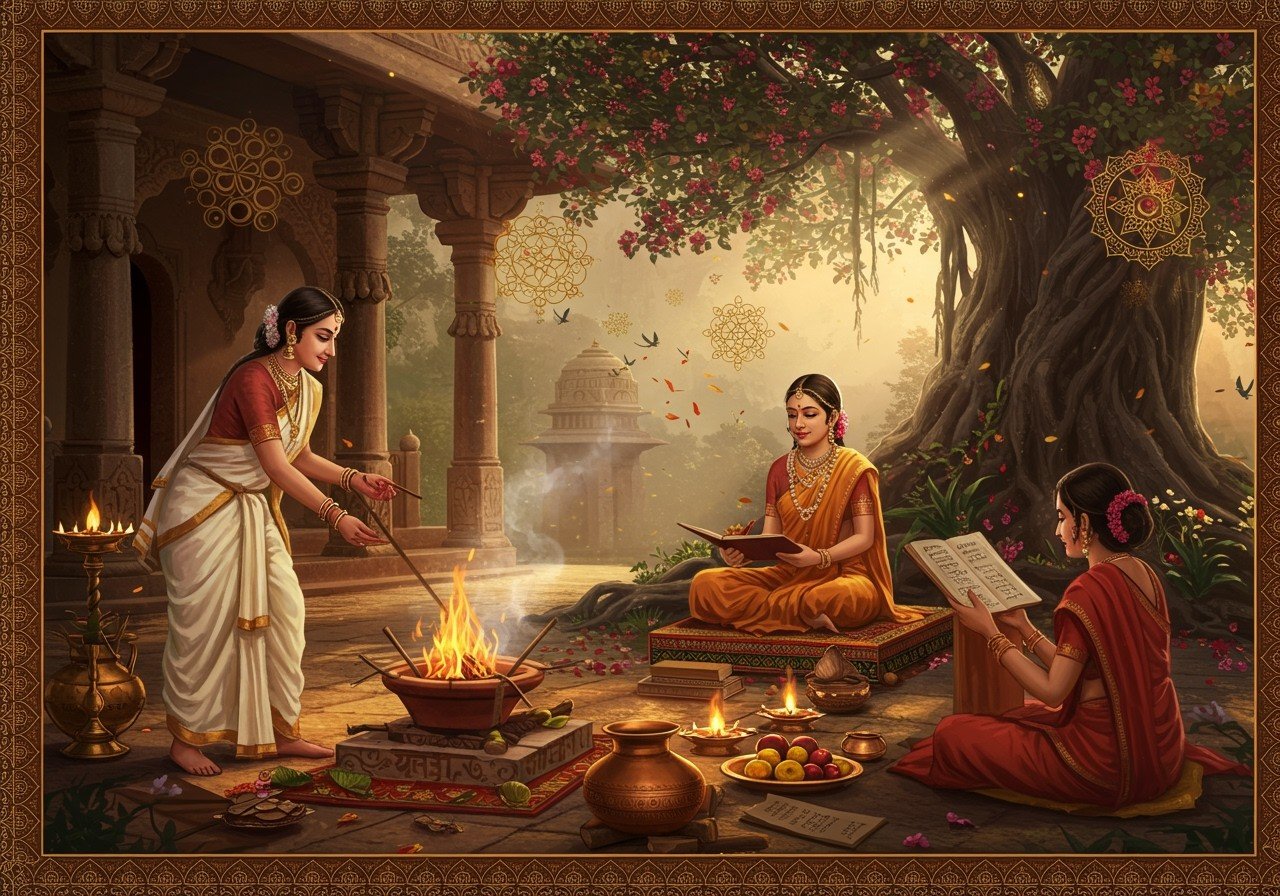
The Vedic Period, spanning from 1500 BCE to 500 BCE, significantly shaped ancient Indian history and culture. This era, divided into the Early Vedic Period (c. 1500-1000 BCE) and the Later Vedic Period (c. 1000-500 BCE), offers valuable insights into the lives of women. While Vedic texts primarily focus on rituals and philosophy, they also shed light on the evolving roles and status of women.
The Early Vedic Period: A Time of Respect and Autonomy
In ancient India, particularly during the Early Vedic period, women enjoyed a high status and were involved in various aspects of life, including education, decision-making, and public activities. They could marry at a mature age and had the freedom to choose their own husbands. Despite the strong presence of patriarchy, women were respected and could participate in war, gymnastics, and other public endeavors.
- Education: Women had access to education and were called “Brahmavadinis” if they pursued Vedic studies. Notable female scholars like Gargi and Maitreyi engaged in philosophical debates with renowned sages, demonstrating their intellectual prowess.
- Marriage: The “Swayamvara” system empowered women to choose their husbands, showcasing societal respect for their preferences and autonomy in marital decisions.
- Property Rights: Women possessed property rights and could inherit and manage “Stridhan,” which included gifts, dowries, and personal earnings. This economic independence contributed to their elevated social standing.
- Participation in Rituals: Women actively participated in religious rituals and ceremonies, playing essential roles in maintaining spiritual harmony within their families and communities.
- Social Activities: Women engaged in various social and cultural activities, including music, dance, and artistic pursuits, enriching the cultural fabric of the Vedic society.
- Political Involvement: Evidence suggests women’s participation in “Sabhas” and “Samitis,” political assemblies where community matters were discussed and decisions were made.
The Later Vedic Period: A Shift in Dynamics
Over time, the status of women saw a declining trend, with men primarily responsible for earning and women for home-making and reproduction of heirs. The Later Vedic Period witnessed a gradual shift in the roles and status of women. While they continued to hold important positions within families, certain restrictions began to emerge.
- Education: The emphasis on women’s education declined, with fewer references to female scholars and a diminishing role for Brahmavadinis. Access to higher learning became more restricted.
- Marriage: “Swayamvara” became less common, giving way to arranged marriages. Child marriage also began to emerge, further limiting women’s autonomy and life choices.
- Property Rights: Women’s property rights became more constrained, and the concept of “Stridhan” narrowed, impacting their economic independence and social standing.
- Participation in Rituals: Women’s participation in religious rituals decreased, with some ceremonies becoming exclusive to men. Their spiritual roles became more defined by domestic practices.
- Social Activities: While women continued to engage in cultural activities, their involvement became more confined to private spaces, reflecting changing social norms and expectations.
- Political Involvement: Women’s participation in political assemblies diminished, signaling a shift towards a more patriarchal social structure. Their public voices were gradually marginalized.
Honoring the Vedic Feminine Tradition with Poojn.in
Poojn.in, India’s leading online store for cultural and religious goods, offers a wide range of products that honor the divine feminine figures of the Vedic tradition. Explore our curated collections for:
- Maa Durga: Find complete puja sets for Durga puja, Navratri celebrations, and other essential items like sindoor, bangles, and traditional clothing.
- Devi Saraswati: Discover white flowers, specific puja items for Saraswati worship, books on the goddess of knowledge, and traditional musical instruments.
- Goddess Lakshmi: Explore Lakshmi yantras, sacred items for wealth and prosperity prayers, pure silver and brass items for aarti, and special lamps and diyas.
Poojn.in provides authentic and high-quality products to support your spiritual practices. Visit our online store to discover a wide selection of items carefully chosen for ritual purity and authenticity.
Conclusion: Reflecting on the Vedic Legacy
The journey of women in the Vedic Period presents a complex picture of evolving roles and status. From the relative autonomy and respect of the Early Vedic Period to the increasing restrictions of the Later Vedic Period, their experiences offer crucial insights into the dynamics of gender in ancient India. As we explore this rich history, we can appreciate the importance of striving for gender equality and honoring the contributions of women throughout history. Poojn.in continues to support this legacy by providing resources that celebrate the divine feminine and empower individuals to connect with their spiritual heritage.
FAQs
How did women’s roles change from the Early to the Later Vedic Period? Women’s roles shifted from greater autonomy and participation in public life to increased domestic focus and restricted access to education and certain rituals.
What are some examples of women’s contributions in the Early Vedic Period? Women like Gargi and Maitreyi excelled as scholars and participated in philosophical discussions, demonstrating their intellectual contributions.
How did marriage practices affect women’s lives during the Vedic Period? The shift from “Swayamvara” to arranged marriages and the emergence of child marriage significantly impacted women’s freedom and choices.


